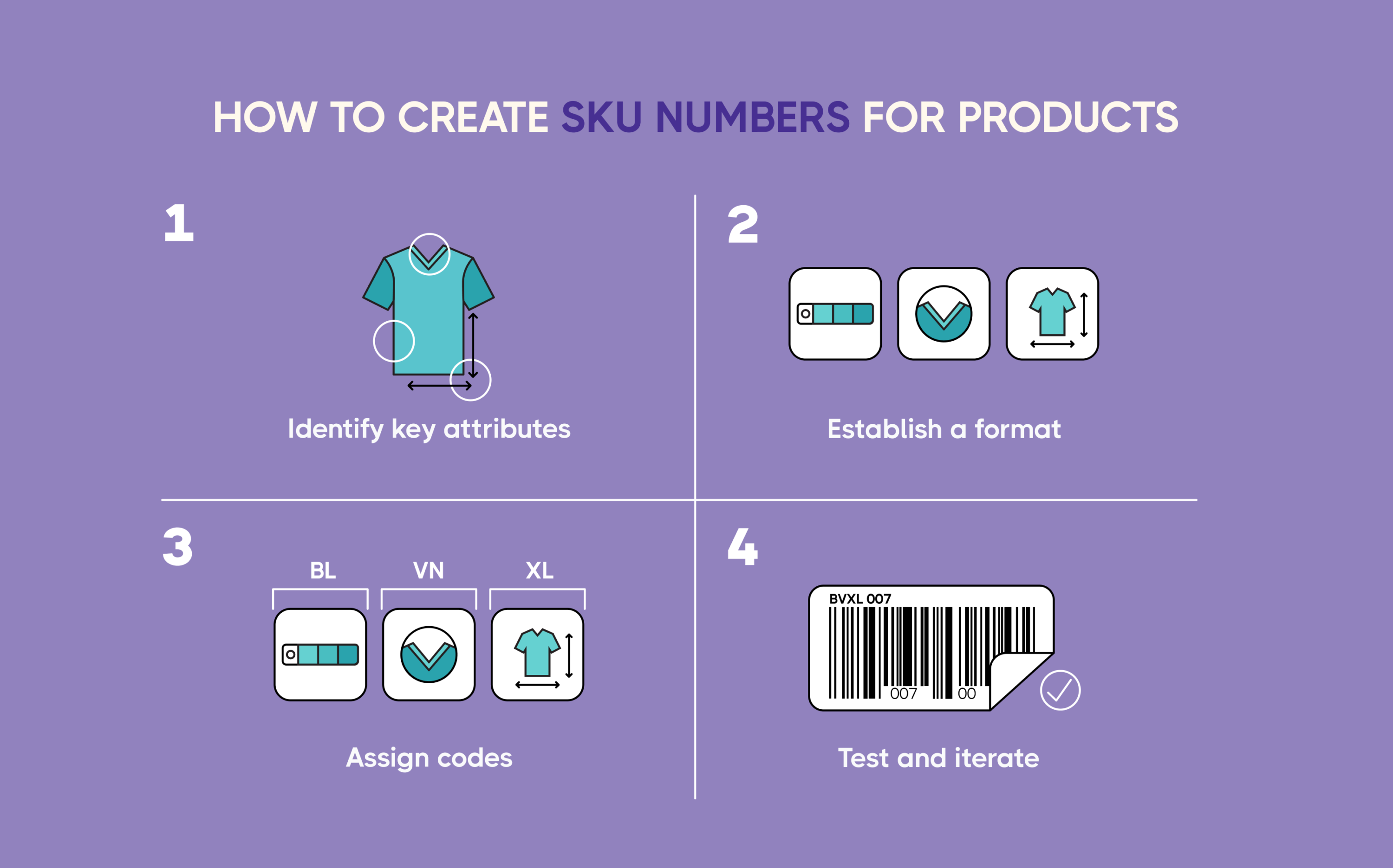
Sahiba Cuccria
8 mins read
11 mins read


Managing inventory in eCommerce requires precision and efficiency, yet many businesses struggle with something as fundamental as locating SKU numbers. These essential codes should be readily accessible, but tracking them down often becomes an unexpected time drain that impacts operations.
These alphanumeric codes are everywhere – on products, receipts, websites – yet finding the right one when you need it can turn into a frustrating hunt. And here's why it matters: research indicates 69% of customers abandon retailers after delivery problems. Many of these issues? Simple inventory errors that better SKU tracking would have prevented.
Whether you're processing returns, updating inventory, or trying to reorder that perfect product, this guide shows you exactly where SKUs hide and how to find them fast
Stock Keeping Units (SKUs) are the internal codes businesses create to track their products. They're not like UPCs, which stay the same everywhere. Each retailer makes up their own SKU system based on what makes sense for their operations.
Target might call a blue t-shirt "TSHRT-BL-M-2024." Walmart? They'd use something completely different like "84739-BMT" for the exact same shirt. Both systems work perfectly fine – it's all about what fits each company's needs.
SKU locations vary depending on what you're looking at and where you're searching. Let's break down the most reliable spots.
Physical products usually have SKUs in predictable spots. Manufacturers know retailers need these codes accessible, so they don't hide them too creatively.
Start with these locations:
Here's something most people don't realize: thermal-printed labels fade badly over time. If you're squinting at a blurry label, grab your phone. Take a photo with flash on – you'd be surprised how much clearer those faded numbers become when lit properly.
Digital shopping makes SKU hunting much simpler. Retailers know customers need these codes for reorders and returns, so they're usually displayed prominently.
Check these spots on product pages:
Quick shortcut: Hit Ctrl+F (or Cmd+F on Mac) and type "SKU" – this search function will jump straight to it 90% of the time.
Receipts are goldmines for SKU information, whether paper or digital:
Pro tip from years in retail: photograph every major purchase receipt. Cloud storage is cheap, and having that SKU accessible months later when you need warranty service? Priceless.
Amazon does things differently with their ASIN system:
Remember, ASIN (Amazon Standard Identification Number) is basically Amazon's version of a SKU. It only works within their ecosystem.
Fashion sites often bury their SKUs:
Business owners, your SKUs live in multiple places:
Modern accounting platforms treat SKUs as essential data:
Each platform has its quirks:
Professional systems offer multiple access points:
Different industries have developed their own conventions:
Electronics manufacturers are pretty consistent:
Shoe companies love the tongue label:
These require more hunting:
When standard methods fail, get creative:
Manufacturer resources
Tech solutions
The importance varies by who you are:
Real numbers from actual implementations:
A 500-order-per-day operation typically saves 2-3 labor hours daily just from better SKU organization. That's $30,000+ annually in labor costs alone.

If you're building SKUs from scratch, here's what actually works:
Keep these principles in mind:
Step 1: Identify Key Attributes
List what matters for YOUR business:
Step 2: Establish Format
Design your template:
Step 3: Assign Codes
The actual creation:
Step 4: Test and Refine
Before full rollout:
Real examples that work:
Notice how each tells a story? That's the goal.
Learn from others' pain:
The right tool depends on your volume. Under 1,000 SKUs? Spreadsheets work fine. Over 10,000? You need real software.
SKUs sometimes seem to vanish. Here's your recovery plan:
The industry's moving fast:
These aren't far-off dreams. Major retailers are testing these systems now.
SKU numbers aren't glamorous, but they're the backbone of efficient commerce. Getting them right saves time, prevents errors, and keeps customers happy. More importantly, a good SKU system grows with your business instead of holding it back.
The difference between thriving operations and daily chaos often comes down to these simple codes. When your SKU system works, everything else – from shipping to customer service – gets easier.
At eShipper, we see the impact of good SKU management daily. Our platform integrates with whatever system you're using, adding visibility and reducing errors across your entire operation. We've helped thousands of businesses turn their SKU chaos into competitive advantage.
Ready to optimize your shipping and inventory operations? Get an instant quote and see how eShipper can streamline your logistics.
Think of it this way: UPC is like a social security number (same everywhere), while SKU is like an employee ID (unique to each company). A product has one UPC but potentially dozens of different SKUs across different stores.
Start simple. Use 8-12 characters that tell a story: category, key features, unique number. Skip confusing characters (0/O, 1/I). Test with a small batch first. The perfect system is one your team actually uses, not the one that looks best on paper.
Absolutely not. This creates inventory nightmares, shipping errors, and accounting problems. Once a SKU is assigned, it belongs to that product forever – even after the product is discontinued.
Ideally? Never. SKUs should last a product's entire lifecycle. Only change them during complete system overhauls or if products fundamentally change. Stability beats optimization here
Yes, and you absolutely should. Same SKU everywhere means cleaner data, easier inventory management, and accurate reporting. The only exception might be if different channels require different formats.
They vary wildly: "BLK-JNS-32-M" or "547839-A" or "PROD-2024-0847". Most are 8-12 characters mixing letters and numbers. The format matters less than consistency.
No. SKU identifies what type of product it is (all blue shirts). Serial number identifies which specific unit (this exact blue shirt). You'll have hundreds of items sharing one SKU, each with unique serial numbers.
Check email receipts, order history on retailer sites, or credit card statements (some show SKUs). Customer service can often find SKUs from product descriptions plus rough purchase dates.
Sure! Many people catalog collections this way. Keep it simple: "COMIC-MARVEL-001" or "TOOL-DRILL-B&D-01". The same principles apply – consistency matters more than complexity.
Normal when products sell through multiple channels. Same shoe might be "NIKE-AF1-WHT-10" at Footlocker but "1847329" at Walmart. Each retailer creates what works for them.
Yes. Software licenses, ebooks, courses, music downloads – all get SKUs. They're inventory just like physical goods, just easier to store.
No, they're proprietary to each business. That's why the same product has different SKUs everywhere. UPCs provide universal identification when needed.
8-12 characters hits the sweet spot. Long enough for useful information, short enough to type quickly. Some use more, but error rates climb with length.
Only at retailers with public lookup tools. Most SKUs only work within their creating company's systems. Major retailers (Walmart, Home Depot) offer lookups. Smaller shops usually don't.
They shouldn't. SKUs remain valid forever, even after products discontinue. Changing SKUs breaks historical data and creates confusion.
Amazon Standard Identification Number – their proprietary SKU system. 10 characters, unique to each product, only works on Amazon. Think of it as Amazon's internal language.
Try the Wayback Machine for old product pages, contact collector communities, check paper catalogs, or reach out to manufacturer archives. Discontinued product forums are surprisingly helpful.
Never. Prices change constantly; SKUs should be permanent. Include only stable attributes: category, size, color, material, style.
Happens all the time since everyone creates their own. "12345" might be shoes at one store, shirts at another. Context matters – always specify which retailer's SKU you mean.
Start with [Category]-[Key Feature]-[Number]. "CANDLE-VAN-L-01" beats "CDL-V-L-1" for clarity. Grow complexity only when needed. Most small businesses over-engineer their first system.